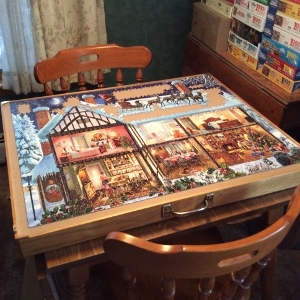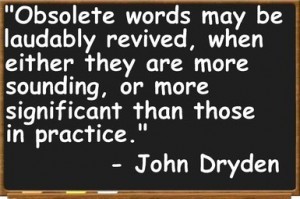Kathy Lynn Emerson's Blog, page 85
January 15, 2016
Weekend Update: January 16-17, 2016
 Next week at Maine Crime Writers there will be posts by Chris Holm (Monday), Lea Wait (Tuesday), Barb Ross (Wednesday), Jen Blood (Thursday), and Maureen Milliken (Friday).
Next week at Maine Crime Writers there will be posts by Chris Holm (Monday), Lea Wait (Tuesday), Barb Ross (Wednesday), Jen Blood (Thursday), and Maureen Milliken (Friday).
In the news department, here’s what’s happening with some of us who blog regularly at Maine Crime Writers:
from Kaitlyn Dunnett: The current puzzle is nearly done.
For those who read my post on Monday, I thought you might like to see what it looks like when just the pieces without “clues” remain to be put in place.
An invitation to readers of this blog: Do you have news relating to Maine, Crime, or Writing? We’d love to hear from you. Just comment below to share.
And a reminder: If your library, school, or organization is looking for a speaker, we are often available to talk about the writing process, research, where we get our ideas, and other mysteries of the business. Contact Kate Flora: mailto: kateflora@gmail.com
January 14, 2016
The Escape Artist Fails Again!
Kate Flora here, following up on a discovery I recently made: that the only way I can stop working is to leave my desk. When I’m at home, that desk projects an energy field (unless it’s a tractor beam) that pulls me back whenever I stray for too long. So I decided to leave my desk behind, buried under a mound of work that wants my attention, and go west. Hike in Tucson and Sedona, snowshoe at Big Bear Lake, and walk the hills of San Francisco.
Getting ready to leave for any trip makes me long for those days when everything wasn’t instant response, quick turn-around, must be done right now. Before cell phones and scanners and e-mail. Back to the days of the Pony Express, when months could pass between request and response. Beyond the obvious, like paying bills and stopping mail, and arranging for a house sitter, on the eve of departure, there is the Intent to Harvest Timber form that must be filed with the State of Maine. A copy of the family trust must be located and copied and mailed to the attorney. Annual bar registration, languishing unattended, must be filled out on line. The surveyor must be nudged about a property description for the deed. The remaining Christmas gifts–opened and left behind–must be mailed to various parts of the country.
At last, everything is in order for escape and it is time to pack. But no! My beloved Lowa hiking boots, that have traipsed through Scotland, slogged through three days of rain and snow on the Milford Track in New Zealand, hiked sacred mountains in Mexico and through the Canadian woods are . . . MISSING! And a search of every closet and places logical and illogical does not help. I am leaving for a hiking trip and I’ve lost my shoes. No time to shop for new ones—when I bought these, I literally spent 2 ½ hours at L.L. Bean trying on every pair in my size and walking up and down their little artificial hill until I found the perfect boots. Instead, into the bag go the dinosaurs—a pair of boots bought at Goodwill 25 years ago, boots so heavy I can barely lift my feet—but ones that are waterproof, elephant-proof, and indestructible. I finish packing and turn to choose some books to read. I’ve got Ann Patchett’s This is the Story of a Happy Marriage and Geraldine Brooks’s March and the always compelling Jeff Deaver on my iPad and as I am shutting down the computer: BING! I’ve got mail.

High up in Sabino Canyon
Of course, you all know that the long tentacles of publishing don’t ever really let go, and so, as has been the case for the past twenty plus years, on the eve of my departure, the edited manuscript for my spring book A Good Man with a Dog—one that of course wants a quick turn-around—arrives in my “In” box. My suitcase is full of hiking gear, snowshoeing gear, and fancy city restaurant gear. Now it is also full of my desk–in the form of my trusty laptop. This reminds me that I’ve edited books on the beach during a quick escape to Bermuda. On the lanai on a trip to Florida. I’ve negotiated a book deal from the hotel business center in Bangkok. And now I will be editing a book at the elegant Huntington Hotel in San Francisco, and remembering that one of my Thea Kozak mysteries, An Educated Death, opens with Thea and Andre at The Clift just down the street.
I will also be pondering the future of my Joe Burgess series, because another BING! brought the news that Five Star is dropping their mystery line. What will be the fate of Burgess five, And Led Them Thus Astray?
Writers leave home to find new ideas, nurture our sense of observation, and to be reminded that this job is about being creative and curious. Walking trails in the wilderness and the stillness is a great time to think about plots and characters. We are also reminded that yes, magical and creative as it is, writing is a job, with deadlines and obligations we can never really get away from.
Meanwhile, it has snowed in Tucson and Sedona, and so perhaps it is good that I have lined, waterproof boots to slog through the mud and ice on my way to the Kachina Woman vortex. Where the world falls away as a man named Bob sits atop a red rock and plays his flute.
https://www.youtube.com/watch?v=Dez1E4O78wA

The rock where Bob is sitting as his haunting flute floats over the canyon

Kachina Woman presiding over her vortex
Lessons 5 and 6: Be Brave and Keep on Trucking, Baby
By Brenda Buchanan
In November and December, I wrote about some of the lessons I’ve learned during my first year as a published author. It’s been affirming for me to write them down and share them publicly, and I’m grateful to everyone who has offered comments to date. Today’s post covers the final two lessons: find your courage and your true path, then keep moving forward.
Lesson #5: Look Fear in the Face and Don’t Blink
Everyone is rattled by something. When you’re writing for publication, many things have the potential to freak you out if you allow yourself to dwell on them.
You might not sell any books.
Reviewers will universally hate what you write.
Crippling writer’s block will seize your soul the day after you launch your first book and you’ll never write another coherent paragraph.
None of those particular terrors went bump in my pre-publication nights.
This time last year the dread that had me studying the ceiling at 3 a.m. was the realization that with the April launch of Quick Pivot, I would have to stand up in front of people and talk about my book. 
Ridiculous, right? A significant part of my livelihood as a lawyer involves speaking publicly. Years ago I addressed an enormous crowd as class speaker at my law school graduation. Since then I’ve tried cases in District and Superior Court and argued before the Maine Supreme Judicial Court.
You would think this experience would help. It did the opposite.
The truth was, lawyer-speaking ruined me (temporarily) for writer-speaking. Over the years I’d learned how to stand up, lay out my case and then defend it, because lawyers are trained to peck at each other’s arguments like famished crows. There’s no precedent to support that proposition. Nobody’s going to buy that story. Your client is living in a fantasy world.
Though I no longer try cases in court, much of my workday communication continues to be verbal swordplay. It may seem more like convincing, cajoling or creative coaxing, but at bottom, it is arguing. I want something. The person across the table or on the other end of the phone wants something else. It’s a battle, even if we pretend it’s not.
Late last winter I realized I needed an intervention to help me overcome my worry that readers would come to their local library so they could tell me in person about the shortcomings in my books. To deal with my anxiety-driven insomnia I went to the best doctor in town—the amazing Elizabeth Peavey.
For those unfamiliar with Liz, she is an accomplished writer, brilliant performer and public speaking coach par excellence. She lives in Portland and is known statewide (should be worldwide) for her many talents. Here’s a link to her website, for anyone who thinks they might benefit from speaking instruction or would like to know more about her terrific writing. http://elizabethpeavey.com/
Liz helped me with technical stuff (among other things, I had the voice-dropping-off-at-end-of-sentence thing going on) and offered vital breathing and posture tips (“your body is a bellows” she, well, bellowed). But the primo takeaway was her conviction—which she promised was true—that at my readings, people would not attack me or my work. “People show up for these events because they enjoy being read to and they love to meet authors,” she said. “They’re cheering for you. They want you to succeed.”
Liz was right. The nicest people in the world have attended my readings. They’ve grinned at me from the audience. They’ve asked thoughtful questions. They’ve even applauded at the end. Having adopted Liz’s bellows-breathing mantra, I have never once fainted and I always leave these events feeling like a million bucks.
 The lesson? When we’re in the grip of any fear, we forget the absolute rush of finally facing it down. My advice for anyone in my (formerly) quaking boots is to brush aside your night-terrors, whatever they may be, and go for it. You’ll be glad you did.
The lesson? When we’re in the grip of any fear, we forget the absolute rush of finally facing it down. My advice for anyone in my (formerly) quaking boots is to brush aside your night-terrors, whatever they may be, and go for it. You’ll be glad you did.
Lesson #6: Be True to Yourself and Keep Going
Like many of you, I always have considered myself a writer. When I left journalism for law school, that essential truth didn’t change. I figured I simply was going to do something else for a while. Eight years ago—20 years after walking away from the keyboard—I decided to get back to it. It was a transformative decision, reconnecting me with my true, core self.
I was well aware that publication would be a long road that I’d need to walk (mostly) by myself, nurturing the blind, radical faith that I’d make it to my destination.
 But when I attained my goal of becoming a published author, my journey wasn’t over. In fact, it had just begun.
But when I attained my goal of becoming a published author, my journey wasn’t over. In fact, it had just begun.
We all know the sun does not set in glory and the credits do not roll after Book One. One must write more books or short stories. That part of the writing process doesn’t magically get easier the second (or third, or fourth) time around. Whether you have a one-book contract or a multiple-book deal, you must keep your publisher happy, and the challenge of staying a published writer is real and somewhat intimidating.
This is where the part about being a writer, not just playing at it, comes in. You need fortitude. Grit. Resilience. If you’re lucky, you won’t have to face the most difficult parts on your own.
I have been fortunate in my rookie year to get to know many well-established writers (including my talented MCW colleagues) who have blazed a trail for me to follow. Their advice? Stay on course, but be flexible. It’s guidance I’m taking to heart as I continue to move forward.
My third book launches on February 1. Here’s the cover. 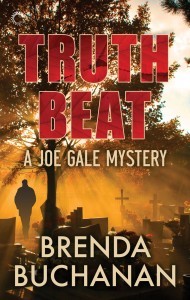
I’m hard at work on a fourth novel, though I don’t have a contract for it. There are a few short story ideas I’m developing without an identified market in mind. I plan to keep on keeping on, maintain the daily rhythm of putting words to paper and leave the tether off my imagination while the future unfolds.
My destination isn’t as clear as it was last year when I was working day and night to fulfill a three-book contract with tight deadlines, but I’m cool with that. I know who I am. I’m a writer. And I’ve got these six lessons in my backpack to keep me on course.
I am so grateful for your company on the journey.
Brenda Buchanan is the author of the Joe Gale Mystery Series, featuring a diehard Maine newspaper reporter who covers the crime and courts beat. The third book—TRUTH BEAT—will be released by Carina Press on February 1. Like QUICK PIVOT and COVER STORY, the earlier books in the series, TRUTH BEAT will be available wherever ebooks are sold.
January 12, 2016
THE BLACK DAHLIA
Vaughn C. Hardacker here returning to True Crime: January 15th will mark the 69th anniversary of what is possibly the most renowned unsolved murder case of the 20th Century United States: The Black Dahlia. Her body was found mutilated, her body sliced in half at the waist, on January 15, 1947, in Leimert Park, Los Angeles, California. Short’s murder has been the source of widespread speculation, leading to many suspects, along with several books, television and film adaptations of the story. Short’s murder is one of the oldest unsolved murder cases in Los Angeles history. So, who was The Black Dahlia and what does she have to do with crimes in New England?
Early Life
The Black Dahlia was Elizabeth Short born July 29, 1924 (22 years old at the time of her death) in Boston, Massachusetts, the third of five daughters of Cleo and Phoebe May (Sawyer) Short. She grew up in the suburb of Medford, Massachusetts. Her father built miniature golf courses until the 1929 stock market crash, when he lost most of his money. One day in 1930, he parked his car on a bridge and was not heard from for years, leading many to presume he had committed suicide. Phoebe May Short moved her family into a small apartment in Medford and went to work as a bookkeeper to support them. It was not until a letter of apology was received that the family learned Cleo Short was still alive, and living in California.
Because she was troubled by asthma and bronchitis, Elizabeth Short was sent at age sixteen to spend the winter in Miami. During the next three years, she would live in Florida during the cold months and spend the rest of the year in Medford. When she was  nineteen, she traveled to Vallejo, California, to live with her father, who was working at the nearby Mare Island Naval Shipyard on San Francisco Bay. Early in 1943, Short and her father moved to Los Angeles, but she left him following an argument, and took a job at the post exchange at Camp Cooke (now Vandenberg Air Force Base), near Lompoc, California. She soon moved to Santa Barbara, where she was arrested on September 23, 1943 for underage drinking (the photo to the left is her arrest photo). The juvenile authorities sent her back to Medford, but she returned instead to Florida, and made only occasional visits to Massachusetts.
nineteen, she traveled to Vallejo, California, to live with her father, who was working at the nearby Mare Island Naval Shipyard on San Francisco Bay. Early in 1943, Short and her father moved to Los Angeles, but she left him following an argument, and took a job at the post exchange at Camp Cooke (now Vandenberg Air Force Base), near Lompoc, California. She soon moved to Santa Barbara, where she was arrested on September 23, 1943 for underage drinking (the photo to the left is her arrest photo). The juvenile authorities sent her back to Medford, but she returned instead to Florida, and made only occasional visits to Massachusetts.
While in Florida, Short met Major Matthew Michael Gordon, Jr., a decorated United States Army Air Force officer then at the 2nd Air Commando Group, where he was training for deployment to the China Burma India Theater of Operations. She told her friends that he had written to propose marriage while he was recovering from injuries from a plane crash in India. She accepted his offer, but Gordon died in a second crash on August 10, 1945, less than a week before Japan’s surrender ended World War II.
Short returned to Los Angeles in July 1946 to visit Army Air Force Lieutenant Joseph Gordon Fickling, whom she knew from Florida. Fickling was stationed at NARB, Long Beach. Short would spend the last six months of her life in southern California, mostly in the Los Angeles area.
Murder and aftermath
On the morning of January 15, 1947, the nude body of Elizabeth Short was found in two pieces on a vacant lot on the west side of South Norton Avenue midway between Coliseum Street and West 39th Street in Leimert Park, Los Angeles. Local resident Betty Bersinger discovered the body about 10:00 am, as she was walking with her three-year-old daughter. Bersinger at first thought it was a discarded store mannequin. When she realized it was a corpse, she rushed to a nearby house and telephoned the police.
Short’s severely mutilated body was completely severed at the waist and drained entirely of blood. The body obviously had been washed by the killer. Short’s face had been slashed from the corners of her mouth to her ears, creating an effect called the Glasgow smile. Short had several cuts on her thigh and breasts, where entire portions of flesh had been sliced away. The lower half of her body was positioned a foot away from the upper, and her intestines had been tucked neatly beneath her buttocks. The corpse had been “posed,” with her hands over her head, her elbows bent at right angles, and her legs spread apart. Detectives found a cement sack nearby containing watery blood. There was a heel print on the ground amid the tire tracks.
An autopsy stated that Short was 5 feet 5 inches (1.65 m) tall, weighed 115 pounds (52 kg), and had light blue eyes, brown hair, and badly decayed teeth. There were ligature marks on her ankles, wrists, and neck. The skull was not fractured, but Short had bruises on the front and right side of her scalp, with a small amount of bleeding in the subarachnoid space on the right side, consistent with blows to the head. The cause of death was determined to be hemorrhaging from the lacerations to her face and shock from blows on the head and face.
Following Short’s identification, reporters from the Los Angeles Examiner contacted her mother, Phoebe Short, and told her that her daughter had won a beauty contest. Only after prying as much personal information as they could from Mrs. Short, did the reporters tell her that her daughter had been murdered. The newspaper offered to pay her air fare and accommodations, if she would travel to Los Angeles to help with the police investigation. That was yet another ploy, since the newspaper kept her away from police and other reporters to protect its scoop. William Randolph Hearst’s papers, the Los Angeles Herald-Express and the Los Angeles Examiner, later sensationalized the case: the black tailored suit Short was last seen wearing became “a tight skirt and a sheer blouse,” and Elizabeth Short became the “Black Dahlia,” an “adventuress” who “prowled Hollywood Boulevard.”
On January 23, 1947, a person claiming to be the killer called the editor of the Los Angeles Examiner, expressing concern that news of the murder was tailing off and offering to mail items belonging to Short to the editor. The following day, a packet arrived at the Los Angeles newspaper containing Short’s birth certificate, business cards, photographs, names written on pieces of paper, and an address book with the name Mark Hansen embossed on the cover. Hansen, an acquaintance at whose home she had stayed with friends, immediately became a suspect. One or more others would write more letters to the newspaper, signing them “the Black Dahlia Avenger”, after the name given Short by the newspapers. On January 25, Short’s handbag and one shoe were reported seen on top of a garbage can in an alley a short distance from Norton Avenue. They were finally located at the dump.

The Grave of Elizabeth Short
Due to the notoriety of the case, over the years more than 50 men and women have confessed to the murder, and police are swamped with tips every time a newspaper mentions the case or a book or movie is released about it. Sergeant John P. St. John, a detective who worked the case until his retirement, stated, “It is amazing how many people offer up a relative as the killer”.
Short was buried at the Mountain View Cemetery in Oakland, California. After her sisters had grown up and married, Phoebe Short moved to Oakland to be near her daughter’s grave. She finally returned to the east coast in the 1970s, where she lived into her nineties.
 This case has always intrigued me and has been the subject of many rumors, books, and movies. It was the inspiration for my upcoming novel, THE BLACK ORCHID (March 1, 2016 from Skyhorse Publishing, Inc.). In a future posting I will talk about some of the suspects and theories of the crime.
This case has always intrigued me and has been the subject of many rumors, books, and movies. It was the inspiration for my upcoming novel, THE BLACK ORCHID (March 1, 2016 from Skyhorse Publishing, Inc.). In a future posting I will talk about some of the suspects and theories of the crime.
Wordplay
John Clark celebrating the beginning of Cabin Fever, an annual rite of Northern New England nuttiness. It’s the time when supposedly sane human beings do all sorts of seriously funny and occasionally scary things. Best friends are at each others throats, armed guards are required at town meeting (more about that come March), sweet church-going folk channel Jack Nicholson’s performance in the Shining when the pothole/frost heave index goes above a certain level and the night echoes with werewolf-like howls under a full moon.

The fun is just beginning
As writers, this event provides endless grist, particularly for short stories and we’re wise to take advantage of it. Good stories can fall in our lap almost at will, but we need to be willing and able to tuck these nuggets away for future use. Last week, I had breakfast with a very diverse group in Augusta, thanks to an invitation by a former co-worker and long time friend. One fellow, who had a pretty important job before retiring, dropped a gold nugget in my lap and had no idea how great a plot it would make for a short mystery story. It might even end up in a Level Best Books entry in a month or so. I hope all of you approach Cabin Fever with an attitude of opportunity and if you find a dandy or two, feel free to share it here at MCW.
I’ve been fascinated with words for as long as I can remember. I even attempted to read the entire dictionary around age ten. I don’t think I made it all the way through, but the vocabulary boost drove teachers nuts, much to the delight of other students. Imagine, if you will, a fifth grader asking the teacher if masticating during recess was all right, or telling her that his father engaged in flagrant philately in front of his children. It’s still fun to drop things like that on kids today.

Make sure to get your card before Town Meeting
My fascination was fired up not long ago when I saw the list of words added to the Oxford English Dictionary in 2015. It got me thinking about the concept of language inflation. After all, most folks I listen to these days use a fraction of what’s included in the OED, while plenty use ones not in it, or butcher those that are.
As writers, is it not be our duty to help those less fortunate by mounting a campaign to hold the line on word proliferation? I’m proposing a campaign to keep a steady state status for the English language. Add a new word, delete one that’s obsolete, misunderstood or no longer relevant. I’m certain each of us who contribute to the blog, as well as regular readers could create a list of five words easily eliminated. If we start small with five per blog member/reader, there are bound to be duplicates. When we’re ready, we can vote for the top 50 or so useless ones and petition the folks in charge of the OED for a de-inclusion protocol.
Here are my five: integrity (modern politics has destroyed it), seersucker, houndstooth (neither is coming back in style), chastity (with apologies to the Bono family) and perambulator (heck most people can’t pronounce it, let alone define it.) On a related note, I’d start a campaign to eliminate hackneyed phrases from the language as well and ‘you know’ would be atop my list. Want to drive yourself insane, listen to an interview with a professional athlete and count the number of times this is uttered.
Below is a list of some of the words added to the OED last year as well as a link to the complete list. I chose this batch for their ‘huh?’ value and used them to create a piece of flash fiction. If you’re so inclined, write your own using my list or words of your choosing from the full list. Feel free to share in the comments section.

Endless fun and you never have to clean the refrigerator door.
Antikythera mechanism, n., backronym, n., batchmate, n. bluff-charging, n., camming, n., chiffonade, v., chiffonaded, adj., chossy, adj., cisgender, adj. and n., comedogenic, adj., diabulimia, n., eliminationism, n., flocculant, adj. and n., freegan, adj. and n., gharara, n., gointer, v., hardware woman, n., heterokont, n. and adj., interleading, adj., jeggings, n., Masshole, n., nanosized, adj., papsak, n., presidentiable, n., redpointing, n., shizzle, adj., sunchoke, n., tenderpreneur, n., ubiquinol, n., utang na loob, n., whoonga, n., yarn bomb, n., zama zama, n.
Durwood Freeb detested the decidualized influx of Massholes, even the nanosized ones. Whenever he found an antique lamp at one of the flea markets he frequented, he bluff-charged it, camming the seller, usually a hardware woman or one of those reformed heterokonts so prevalent up and down Route One. As soon as he could, he’d rub it, hoping this was the one with that freegan genie inside.
More often than not he’d end up with another useless Antikythera mechanism to throw in his papsack, destined for the shizzle pile once he returned to his backronym, a three room hovel overlooking the Belfast transfer station.
Durwood hadn’t always been so dour, but after the love of his life a cisgender batchmate of his best friend, twice removed, yarn bombed him at zama zama practice when they were sophomores in high school, he’d been prone to redpointing anyone remotely comedogenic.
Eventually this flocculant condition resulted in chronic eliminationism coupled with embarrassing bouts of diabulemia. After two years of pretending he wasn’t ill, Durwood could no longer ignore the bulging gointer on his forehead.
Belfast was rife with new age practitioners. Despite his having a natural distrust of such charlatans, Durwood was so desperate he tried sunchoke therapy, but that just made him run around on hot days screaming that he was being pursued by untan na loobs who wanted to chiffonade him.
Even a stint in a steam tent drinking chossy whoonga failed to relieve his growing anxiety. He was so terrified he even went to a presidentiable rally where that tenderpreneur Donald Trump was interleading the beguiled by promising he would lay waste to the fools ruining the country
Sadly, not even the Donald was powerful enough to protect Durwood from interleading immigrants from Gharara, whose ubiquinol threats of terrorism were everywhere. “Screw this,” he said, rolling up the legs of his jeggings, “I’m hitching to Millinocket and nevah comin’ back.”
January 10, 2016
Jigsaw-Puzzle Therapy
Kaitlyn Dunnett/Kathy Lynn Emerson here, today sharing my theory that doing jigsaw puzzles is beneficial to mental health.
It’s no accident that my husband has a retirement business specializing in making wooden jigsaw-puzzle tables, or that I gave that same specialization to Liss MacCrimmon’s husband, Dan Ruskin, in my cozy mystery series. I’ve been putting jigsaw puzzles together for decades. About ten years ago, I designed the prototype for a puzzle table and asked my husband to build it for me. Why? Mostly because I was tired of chasing down pieces the cats had knocked on the floor, especially the ones with bite marks in them.
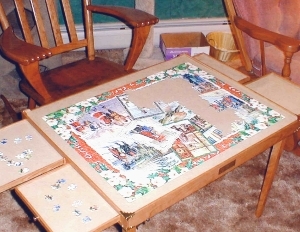
puzzle from a few years back with the table on its removable legs
It took me a little longer to realize that when I remember to follow certain guidelines, doing jigsaw puzzles isn’t just an enjoyable hobby. It has the added advantage of exercising a different part of the brain than the one I use for writing, and it is also a major stress reducer.
Notice I say guidelines, not rules. There are many different ways to go about working a jigsaw puzzle, and most people have a favorite technique that suits them just fine. How to sort the pieces, what part of the puzzle to work on first, and how large the finished puzzle will be are only a few of the decisions individuals make. Some folks continually challenge themselves with more and more difficult puzzles. Others only do landscapes. Or castles. Or reproductions of famous paintings.
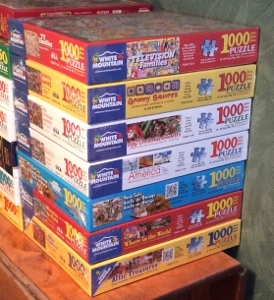
puzzles to do in 2016
My guidelines are fairly simple. I do like a challenge . . . but not so much of one that I get frustrated. That’s why I avoid puzzles with vast areas in all one color. Too much sky, too much snow-covered ground, even too many flowers and I’m going to drive myself nuts trying to put the pieces together. My favorites these days are the collages produced by White Mountain Puzzles in New Hampshire. Since they are made up of dozens of smaller scenes—everything from movie posters to patchwork quilts to cats to candy wrappers—there are clues in almost every piece to hint at where it belongs. With 1000 pieces in all, this doesn’t mean putting the puzzle together is easy, but it isn’t impossible, either. As an added bonus, White Mountain puzzle pieces are thicker than most, making it easier on my arthritic fingers.
When I put a puzzle together, I like to start by finding the border pieces in the box and assembling the four sides. Once that’s done, I use the four drawers, two on each side of my custom-made jigsaw-puzzle table, to put all the remaining pieces right side up. I also have a larger sorting board that is separate from the puzzle table. With these I can put almost all the pieces out so I can see what’s on them. There will be a few left in the box and I turn these over, too. As I work the puzzle and use pieces from the sorting trays, I move the pieces in the box into the empty spaces. As things progress further, I gradually eliminate the large tray, and then each of the drawers, consolidating until there’s only one and I’m on the home stretch.
Okay, I admit it. I’m a tad obsessive arranging and rearranging the pieces. I find it soothing. That’s a good thing, right?
When I work on a puzzle, I constantly look for clues. With those collage puzzles I mentioned, there are sometimes interior borders. If there are, I build the outlines of those smaller scenes and then look for the pieces to fill them. Faces make great clues. If there are people in the scenes, I pull out all the face and body pieces and using the illustration on the box the puzzle came in, place them approximately where they belong.
I can hear some of you muttering that it’s cheating to use the picture on the box to help put the puzzle together. Not if you’re trying to avoid frustration. If you like the challenge of figuring it out for yourself, by all means go for it. I understand there are even some puzzles that come without a picture.

day two
Sometimes I do choose a puzzle that doesn’t contain a lot of clues because I like the look of it. That usually means I complete everything but a swath of one color or design first. To finish, I sort the remaining pieces by shape. Usually, there are only about a half dozen shapes. Once I have them sorted, I simply try each piece that might fit a given space until I find the right one. This is repetitive and time-consuming. It would drive me crazy to do an entire puzzle that way, but it gets the job done. I have heard there are puzzles where every single piece is a different shape. Now that makes me shudder, but others obviously feel differently. To each his own!

last puzzle completed in 2015
About twice a year, I get to enjoy the rush of pleasure that comes from typing “the end” on the final page of a novel. In between those times, I satisfy my need to finish something by completing jigsaw puzzles. There’s a wonderful sense of accomplishment that comes from admiring the final result of all those hours spent putting pieces together.
And it’s much cheaper than seeing a therapist.
Any other jigsaw-puzzle fans out there? I’d love to hear how you approach putting your puzzles together and whether you are looking for a challenge, or a way to relax, or both when you start a new puzzle. And if anyone is interested in a custom-made jigsaw-puzzle table, you can find them at JigsawPuzzleTables.com
Kathy Lynn Emerson/Kaitlyn Dunnett is the author of over fifty books written under several names. She won the Agatha Award in 2008 for best mystery nonfiction for How to Write Killer Historical Mysteries and was an Agatha Award finalist in 2014 in the best mystery short story category for “The Blessing Witch.” Currently she writes the contemporary Liss MacCrimmon Mysteries (The Scottie Barked at Midnight) as Kaitlyn and the historical Mistress Jaffrey Mysteries (Murder in the Merchant’s Hall) as Kathy. The latter series is a spin-off from her earlier “Face Down” series and is set in Elizabethan England. Her websites are www.KaitlynDunnett.com and www.KathyLynnEmerson.com
January 8, 2016
Weekend Update: January 9-10, 2016
 Next week at Maine Crime Writers there will be posts by Kaitlyn Dunnett/Kathy Lynn Emerson (Monday), John Clark (Tuesday), Vaughn Hardacker (Wednesday), Brenda Buchanan (Thursday), and Kate Flora (Friday).
Next week at Maine Crime Writers there will be posts by Kaitlyn Dunnett/Kathy Lynn Emerson (Monday), John Clark (Tuesday), Vaughn Hardacker (Wednesday), Brenda Buchanan (Thursday), and Kate Flora (Friday).
In the news department, here’s what’s happening with some of us who blog regularly at Maine Crime Writers:
Lea Wait: Excited that this week the third book in my Mainely Needlepoint series, THREAD AND GONE, was published! So a few events to celebrate it …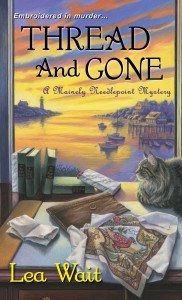
Sunday night, January 10, I’ll be Lisa Haselton’s guest at The Writer’s Chatroom, an online venue, from 7 until 9 p.m. EST, when I’ll be answering questions (from YOU??) To find out more, check http://www.writerschatroom.com … and join Lisa and I Sunday evening! It should be fun! As I say when I speak to groups in person: no subjects are off-limits!
Then, if you’re in Maine, I’ll be out and about later in the week. Thursday, January 14, I’ll be speaking about my Mainely Needlepoint series (and anything else you’d like to hear about) at the Prince Memorial Library , 266 Main Street, Cumberland, Maine. Copies of all my books will be available.
Then Friday, January 15, I’ll be one of about 25 authors and illustrators who’ll be signing our books from 6 until 8 p.m. at the Nerdy Authors Evening at the Falmouth Elementary School in Falmouth, Maine. (This is a part of the 3rd Nerd Camp New England — for more info see http://nerdcampnorthernnewengland.blo...)
If you missed this last week, several Maine Crime Writer regulars, as well as our guest bloggers, will be participating in a discussion of the Portland Stage Company production of The House of the Baskervilles and talking mystery in Maine at the reception that follows. Here’s more about that:
See THE HOUND OF THE BASKERVILLES and then join Crime Writers Kate Flora, Gayle Lynds, Lea Wait, Chris Holm, Paul Doiron for a discussion immediately following the Sunday, January 31st 2pm Matinee at the Portland Stage, 25 Forest Avenue! Complementary wine and cheese reception to follow discussion. Sir Arthur Conan Doyle’s most celebrated Sherlock Holmes story gets a gloriously funny makeover in this cheeky spoof adapted by Stephen Canny and John Nicholson of the hit comedy team Peepolykus. This rollicking good show has Sherlock Holmes and Dr. Watson unraveling the mystery of Sir Charles’ death and the curse of the hound! Packed full of the verbal and visual ingenuity that Peepolykus is known for, this fast-paced comedy offers a slapstick adaptation of this classic tale featuring three actors in various roles. http://www.portlandstage.org/show/the-hound-of-the-baskervilles/
And looking farther down the road, final plans are being made for the Maine Crime Wave, Maine’s own mystery conference, to be held at the Portland Public Library on Saturday, April 9th, with a repeat of last year’s fun Friday night event, Two Minutes in the Slammer. Stay tuned for more details.
invitation to readers of this blog: Do you have news relating to Maine, Crime, or Writing? We’d love to hear from you. Just comment below to share.
And a reminder: If your library, school, or organization is looking for a speaker, we are often available to talk about the writing process, research, where we get our ideas, and other mysteries of the business. Contact Kate Flora: mail to: kateflora@gmail.com
January 7, 2016
GOT GOALS?
Susan Vaughan here. I don’t generally do resolutions. Whenever I’ve tried, they never work out or I realize I’ve made the wrong ones or I break them before January is over. So usually I just move on into the next year without plans. This year I’ve come up with some, let’s call them goals. Two are related to writing and two to life in general.
We published writers need to promote our books, but too often personal appearances, Twitter and Facebook posts and yes, let’s be honest, blog posts get in the way of writing that next book. Whenever newly published authors ask more seasoned ones what they should do to sell more books, the wise old guard reply, “Write the next book and make it better than the previous one.” Absolutely true, but promotion and marketing are essential too, and no one can say what exactly works to sell more books. And all too often, creating a graphic for Twitter or Facebook, like this one–
–diverts me from what I ought to be doing, writing. Keeping all that in mind, GOAL #1 is to write first before I do promotion.
Yup, that’s pretty general, so coming up next is a specific one. Two years ago, after writing a totally new series, I started writing a mystery, a traditional mystery, not romantic suspense. But editing and revising the new romantic suspense series demanded my time, brain, and creativity, so the mystery sat on the computer’s virtual shelf. My Devlin Security Force series was published in 2015, and now it’s time to return to the mystery. How much have I written? I estimate it’s about half finished, about forty thousand words. It’s set on a Maine peninsula I used previously in Once Burned and features the detective from Primal Obsession. So GOAL #2 is to finish the mystery, so here’s my villain.
Now for some non-writing goals. This one came from my husband, so I’m tagging along. GOAL #3 is to enjoy live music once a month. The mid-coast of Maine offers many opportunities for a wide variety of music. The Rockland Strand presents concerts by well-known musicians. We have tickets in February to a concert by guitarist and songwriter Richard Thompson. For this month, we can have coffee or a glass of wine at the Highlands Coffee House in Thomaston and tap our feet to jazz or have a burger at the Quarry Tavern in Tenants Harbor and listen to soft rock or country or oldies. I’m on it!
Last is a goal for all of us. GOAL #4 is said best by writer Neil Gaiman: “May your coming year be filled with magic and dreams and good madness. I hope you read some fine books and kiss someone who thinks you’re wonderful, and don’t forget to make some art—write or draw or build or sing or live as only you can. And I hope, somewhere in the next year, you surprise yourself.”
*** My latest release is Always a Suspect, the prequel to my Task Force Eagle series. The Devlin Security Force series consists of On Deadly Ground, Ring of Truth, and Cleopatra’s Necklace. Nearly completed is a companion wedding novella, to be titled “At Last.” You can find more information about my books at www.susanvaughan.com.
Hey writers, hearing is believing: Let’s go to the audio book
Hi, Maureen here.
I’m not a person who listens to audio books much. Or at all, really. I’m not against them, they’re just not my thing. But I was intrigued at this year’s New England Crime Bake when fellow mystery writer Dale Phillips gave a talk on the benefits of an author’s book also being “published” as audio.
I’ll leave the nuts and bolts to Dale, who has blogged about it on this site.
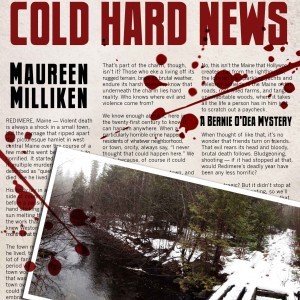
The cover for the audio version of Cold Hard News.
But here’s the great part for writers: Listening to the recorded chapters as the book goes to production so I can help correct errors has made me think a lot about my writing and see it in a different light. I’ve often heard writers advise that reading a work out loud during the writing process helps clarify things. I believe them. Just rarely did it. But listening to Cold Hard News has been a huge help with the writing I’m doing now.
A lot of the reminders go right to the fundamentals: It’s much easier to recognize an overused word or phrase when you keep hearing it — when you’re writing, you may pass over it without noticing. I won’t list them here, in case you didn’t notice them when you read the book, but man, they’re there.
It’s also easier to be reminded of the rhythm of sentences, and using shorter ones in conjunction with longer ones. That’s a writing technicality it’s easy to forget about as I get caught up in trying to get the story down.
Then there is chapter length. Nothing highlights the length of a chapter more than seeing its length in minutes. Most of those in Cold Hard News are in the 11 to 20 range. Then suddenly, as I was listening, there was one more than 40 minutes. Ugh. My immediate thought was “I bet that could have been two chapters.” I was right.
I look forward to hearing what audio book listeners have to say about the Cold Hard News audio version after it comes out at the end of this month. (If you want to listen to a couple minutes, go to my website, maureenmilliken.com, where I’ve created a little video to go with the audio sample that’s been provided.)
But the big benefit for me so far as it’s refocused my writing on the basics as I try to finish up No News is Bad News, the next book in the Bernie O’Dea series.
Maureen Milliken is the author of Cold Hard News. Follow her on Twitter at @mmilliken47 and like her Facebook page at Maureen Milliken mysteries. Her website it maureenmilliken.com. Sign up there for email updates.
January 5, 2016
What Brought Me Happiness in 2015
Dorothy Cannell:
Reflections on what brought me happiness in 2015
Being part of the Maine Crime Writers community and meeting up at events including
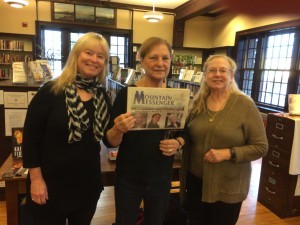
At the beautiful Rangeley Library
library programs where the welcomes have always been heartwarming.
Publication of Death at Dovecote Hatch, second of my new series set in England during the early nineteen thirties. Working on the third – Peril in the Parish – and having a plot shift surprise me in the middle.
Receiving revenue from backlist via e-book sales. It has been particularly pleasing that Down the Garden Path – my second mystery and a non-series – is one of the bigger sellers. Further good news in this regard is that Alibi has picked up Withering Heights and Goodbye Miss Chips and is putting some publicity behind them.
Attending Malice Domestic, Bouchercon, Magna Cum Murder, and Crime Bake. At each had a great time getting together with old acquaintances and getting to know new people – writers and readers. Also spent a wonderful weekend at the Jessup Library’s first Booked for Murder.
Having a short story featuring Hyacinth and Primrose Tramwell (from Down The Garden Path and The Widow’s Club) accepted for the anthology Red Dawn (Best New England Crime Stories) edited by Mark Ammons, Katherine Fast, Barbara Ross, and Leslie Wheeler.
Discovering Ann Cleeves’ wonderfully atmospheric and impressively plotted Shetland Series. Not once in the seven books did I guess the identity of the murderer. I was already an admirer of her Vera books.
Watching English mystery series on TV. I wasn’t enthused about the new modern day Sherlock until my nineteen year old grandson talked me into watching an episode with him and was instantly hooked. My husband Julian and I just finished watching all six seasons of Detective George Gently set in the nineteen-sixties and were bereft until the discovering the availability of season nine of Foyles’ War.
Last but certainly not least is the happiness of the ordinary: Julian bringing me a raspberry turnover after grocery shopping at Hannaford; seeing the bay across the road from our living room windows; staying in my pajamas all day if I wish; basking in the company of our dog and two cats; discovering easy recipes – most recently for baking salmon filets at 400 degrees for twenty minutes in maple syrup and bourbon.
Here’s to 2016!
Dorothy

